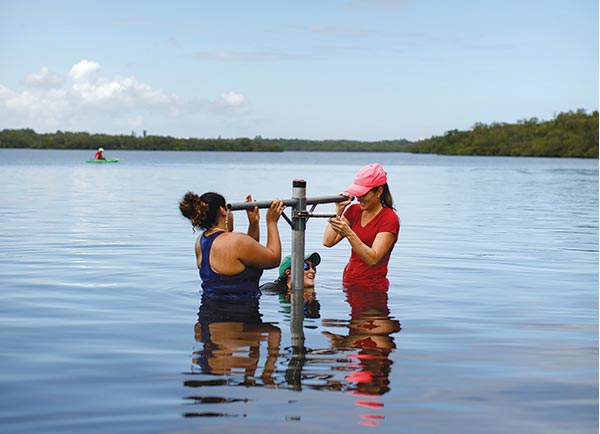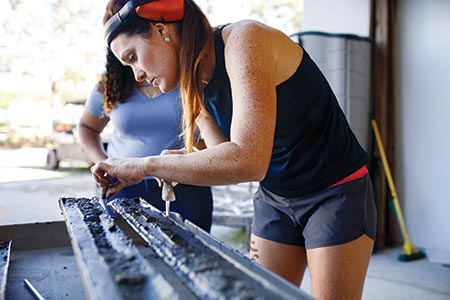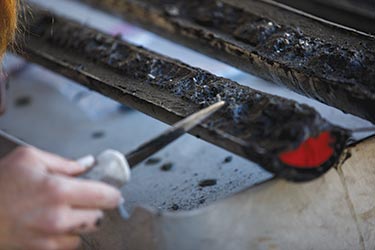When it comes to hurricanes, Jo Muller can predict the intensity of future storms by digging up the past – literally. What she is unable to foresee is if and how mankind will respond to the scientific challenges of global warming. Prior to being recruited in 2011 to join Florida Gulf Coast University’s Department of Marine and Ecological Sciences, the Australian native was already well up to her neck in offshore sediment analysis, hand driving a hollow tube deep into the ocean floor to study storm sediment dating back thousands of years. Her fascination with the relatively new but fast-growing barefoot field of study earned Muller a doctoral degree in paleoclimatology from Australia’s James Cook University and Imperial College in London, followed by a postdoctoral fellowship at the prestigious Woods Hole Oceanographic Institution in Massachusetts. Today she is an associate professor at FGCU.

What can a shaft of dripping beach sand possibly reveal about our stormy past? Plenty, it turns out. According to Muller, while human accounts of hurricanes date back a mere 160 years, the cores enable paleoclimatologists to study the strength and frequency of storms dating back more than 1,000 years.
“For example, we have a record here for Naples that is about 1,200 years old,” Muller says. “One of the purposes of this field is to understand hurricane history, especially natural variability before humans were affecting climate. Then you can start to look at the trends of storms and their potential relationship to long-term climate drivers like sea surface temperatures. Here in Southwest Florida, there’s been very, very little research done. The only published research is from our group, so it’s largely untouched.”

To get an even clearer picture of the past, paleoclimatologists share their gritty findings with core samples collected elsewhere. “Our local record looks very similar to the one from the Florida Panhandle and the one from Belize,” Muller says. “And that’s nice. It makes you feel like what you’re seeing is real.” Next stop for team Muller: Florida’s east coast.
The expanded view from below the waterline has been quite an eye opener for hurricane scientists. By examining the increased storms of what’s termed the “Medieval warm period” (roughly 800- 1600 AD) and the subsequent cool-down of the “Little Ice Age” (1400-1700 AD) that followed, it’s been easier to predict the hurricane havoc ahead, courtesy of manmade global warming.
“The real difference now is the rapidity of the warming,” Muller explains. “In all our records, there has never been evidence of this sort of rapid warming. The only way it’s been shown on so many different experiments and climate models is that it can only be related to fossil fuel emissions.”
As our oceanic and atmospheric temperatures continue to rise, what effect will this have on Florida’s least-welcome seasonal visitors?
“All of our hurricane research points to the idea that there will be stronger storms but not necessarily more frequent storms,” Muller says. “Why? Because we’re providing the conditions that storms really enjoy: warmer sea surface temperatures, higher atmospheric water vapor. Those warm seas are not just at the surface; the warm water is extending quite deep. If you can provide those things, then the storms themselves can grow really large in size, like (2017 Cat 5) Hurricane Irma.”
Research has turned up one encouraging hurricane trend however. “One of the predictions with a warming atmosphere is that wind shear will actually increase, so there is a caveat there that if there’s more wind shear, it might help break more of these storms apart,” she adds.
It doesn’t take a coring tube to discover that global warming is a sensitive subject in today’s political dialog. How does it feel when a paleoclimatologist steps forward with the news from ground zero? “I think initially there was some discomfort when I gave public talks and I got kind of harassed. That wasn’t fun,” Muller admits. “But I’ve learned that if I’m not out there discussing these things, then I’m almost on the other side. I find I have a duty to do that. And as an academic at FGCU, 12.5 percent of my job is service. I feel very strongly toward that aspect and making sure that this science is reaching the general public.”

Chief among her pastimes is pulling the public’s head out of the sediment of powerlessness and despair that global warming can’t be licked by offering tools to help the planet literally cool down. “We talk about that a lot, where people feel like they can’t fix something, Unfortunately, what is out there about climate change is very negative, and it is easy for scientists to focus on all the bad stuff without offering lots of opportunities for people to make changes or give them advice on that,” Muller explains.
One of her favorite tools is Drawdown, a 2017 scientific workbook that features 100 substantive solutions to reverse global warming. “Obviously the big one is stop emitting so much CO2. But others include making things like air conditioners and coolant systems more efficient, eating more plant-based food and actually just eating more of the food you buy,” Muller says. “The amount of waste humans create from just buying food and not eating it is significant.”
One Drawdown solution that surprises most on first encounter is the education of women. “That increase in CO2 emissions is mostly related to population increase, and that is occurring in countries where education is pretty poor,” she explains.
“When you think about the African continent, most women will have four to seven children, but it’s been shown that an educated woman in that environment will have two to three. So just by educating women in those targeted areas, you can maybe draw that down to two. That, in itself, is overwhelming. While it’s hard for me to individually effect change like that – that really has to be at a larger level – it also can really help to broaden this topic.
There are small things that people can do to reduce CO2 emissions and their footprint, while there are other topics that our governmental bodies really need to be looking at, and that’s where voting comes in.” Muller admits that one of her personal challenges is to instill a sense of public service and confidence in her budding paleoclimatologist students. “I have these conversations with my students a lot, because they feel that same sense of despair,” she says.
“I think it’s really important to remain positive about how we can effect change, instead of just talking about all the issues associated with climate change. My students always say to me, ‘Oh my God, what about the Earth?!?’ and I’m like, ‘The Earth is going to be just fine; it has been for 4.5 billion years. It’s more about us as humans.
Do we want to create these really difficult conditions for ourselves?’” True to her philosophy, Muller unwinds by competing in triathlons and Iron Man competitions. “I cycle, I run, I swim. I really like being outdoors, so I do a lot of it,” she says. The solo nature of her relaxation also gives her time to ponder how to best prepare for Florida’s coming mega-storms. “How do we make sure that we’re prepared for a future where we will potentially see stronger storms like Irma and Harvey and Maria and Michael? With planning, that’s how,” she says. “Make some decisions upfront with your family regarding when you will stay, when you will leave and how you will prepare your home. That sort of planning can really take away the stress and make you a lot safer.”